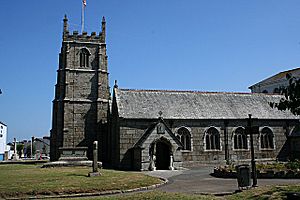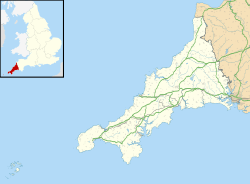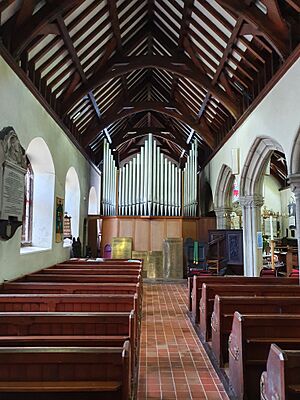St Martin and St Meriadoc's Church, Camborne facts for kids
Quick facts for kids St Martin and St Meriadoc's Church, Camborne |
|
|---|---|

St Meriadoc's Church, Camborne
|
|
| 50°12′48.4″N 05°18′07″W / 50.213444°N 5.30194°W | |
| Location | Camborne, Cornwall |
| Country | England |
| Denomination | Church of England |
| History | |
| Dedication | St Martin and St Meriadoc |
| Administration | |
| Parish | Camborne and Tuckingmill |
| Deanery | Carnmarth, North |
| Archdeaconry | Cornwall |
| Diocese | Truro |
| Province | Canterbury |
St Martin and St Meriadoc's Church, Camborne is a very old and important church. It is a Grade I listed building, which means it's considered a special historic place. It belongs to the Church of England and is located in Camborne, Cornwall.
Contents
History of the Church Building
This church is really old, going back to the Middle Ages. Most of what you see today was built in the 15th century.
First Big Renovation (1861-1862)
The church got a major update between 1861 and 1862. A large gallery at the back of the church was taken out. New roofs were put on the chancel (the area around the altar), the main part of the church (nave), and the north aisle (a side section).
The old, tall pews were replaced with lower, open seats. The floor in the chancel was covered with fancy tiles. The rest of the floor got Minton tiles in red, buff, and black patterns. The pulpit, where sermons are given, was moved to the north side of the chancel. A new font, used for baptisms, was placed at the west end of the nave.
All this work was overseen by an architect named James Piers St Aubyn. These changes made space for 488 people to sit. A beautiful stained glass window was also added to the west tower.
Second Big Renovation (1878-1879)
The church needed more space because more people were coming to services. So, another big renovation happened from 1878 to 1879. Again, James Piers St Aubyn was the architect.
A new south aisle was added. It was 80 feet long, 65 feet wide, and 30 feet high. This new section had four large granite windows along its side. At each end, there were two even bigger granite windows. The old south aisle became the new middle aisle. This expansion added space for 180 more people.
A new heating system was also installed. It was in a room under the church and sent warm air through pipes. This made the church much more comfortable. The church officially reopened on August 7, 1879. The Bishop of Truro, Edward Benson, led the reopening ceremony.
Church Community
St Martin and St Meriadoc's Church is part of a group of churches. It works together with:
Special Memorials
Inside the church, you can find monuments and memorials. These are special tributes to people who were important in the past. Some of these include:
- Sir William Pendarves (who passed away in 1683)
- Sir William Pendarves (who passed away in 1726), created by James Paty the Elder
- Any Acton (who passed away in 1780)
- Grace Percival (who passed away in 1763)
- Edward William Wynne Pendarves (who passed away in 1853)
The Church Organ
The church has a wonderful organ. It was first played on November 8, 1868. This organ was built by John Nicholson. It had two keyboards and many different sounds, called "stops." Mr. E.P. Thomas became the church's first organist.
The organ was updated in 1901 by T.W. Spraggs. Its control area was moved to its current spot. In 1929, it was made even bigger by George Osmond, adding a third keyboard. Then, in 1954–55, Hele & Co rebuilt it with a new type of action. You can find detailed information about this organ in the National Pipe Organ Register.
Church Bells
The church tower holds a set of eight bells. Five of these bells were made by Thomas Rudhall in 1767. The other three bells were made by John Taylor and Company in 1882. These bells ring out for services and special occasions.



